Angiotensin AT(2) receptor contributes towards gender bias in weight gain
- PMID: 23341867
- PMCID: PMC3546084
- DOI: 10.1371/journal.pone.0048425
Angiotensin AT(2) receptor contributes towards gender bias in weight gain
Abstract
Obesity is a major disease condition, in turn leading to pathological changes collectively recognized as metabolic syndrome. Recently angiotensin receptor AT(2)R has been associated negatively with body weight (BW) gain in male mice. However, the gender differences in AT(2)R and BW changes have not been studied. To understand the gender based role of AT(2)R involving BW changes, we fed male and female wild type (WT) and AT(2)R knock out (AT(2)KO) mice with C57BL6 background with high fat diet (HFD) for 16 weeks. The male AT(2)KO had higher HFD calorie intake (WT: 1280±80; AT(2)KO:1680±80 kcal) but gained less BW compared with the WT (WT: 13; AT(2)KO: 6 g). Contrary to the male animals, the female AT(2)KO mice with equivalent caloric intake (WT: 1424±48; AT(2)KO:1456±80 kcal) gained significantly more BW than the WT mice (WT: 9 g; AT(2)KO: 15 g). The male AT(2)KO on HFD displayed lower plasma insulin level, less impaired glucose tolerance (GT), and higher plasma T3 compared with WT males on HFD; whereas the female AT(2)KO mice on HFD showed elevated levels of plasma insulin, more impaired GT, lower plasma T3 and higher free fatty acid and hepatic triglycerides compared with WT females on HFD. Interestingly, compared with WT, AT(2)KO female mice had significantly lower estrogen, which was further reduced by HFD. These results suggest that AT(2)R in female mice via potentially regulating estrogen may have protective role against BW gain and impaired glucose tolerance and lipid metabolism.
Conflict of interest statement
Figures



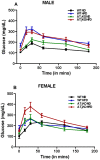
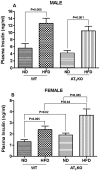
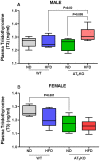
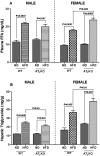
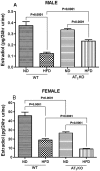
Similar articles
-
P2Y2 Receptor Promotes High-Fat Diet-Induced Obesity.Front Endocrinol (Lausanne). 2020 Jun 3;11:341. doi: 10.3389/fendo.2020.00341. eCollection 2020. Front Endocrinol (Lausanne). 2020. PMID: 32582029 Free PMC article.
-
TNFα gene knockout differentially affects lipid deposition in liver and skeletal muscle of high-fat-diet mice.J Nutr Biochem. 2012 Dec;23(12):1685-93. doi: 10.1016/j.jnutbio.2011.12.001. Epub 2012 Mar 29. J Nutr Biochem. 2012. PMID: 22464148
-
Increased susceptibility to diet-induced obesity in histamine-deficient mice.Neuroendocrinology. 2006;83(5-6):289-94. doi: 10.1159/000095339. Epub 2006 Aug 22. Neuroendocrinology. 2006. PMID: 16926531
-
Sex-specific effect of AQP9 deficiency on hepatic triglyceride metabolism in mice with diet-induced obesity.J Physiol. 2024 Jul;602(13):3131-3149. doi: 10.1113/JP284188. Epub 2023 Apr 22. J Physiol. 2024. PMID: 37026573
-
Adipose tissue (P)RR regulates insulin sensitivity, fat mass and body weight.Mol Metab. 2016 Aug 23;5(10):959-969. doi: 10.1016/j.molmet.2016.08.009. eCollection 2016 Oct. Mol Metab. 2016. PMID: 27689008 Free PMC article.
Cited by
-
Chronic administration of the angiotensin type 2 receptor agonist C21 improves insulin sensitivity in C57BL/6 mice.Physiol Rep. 2018 Aug;6(16):e13824. doi: 10.14814/phy2.13824. Physiol Rep. 2018. PMID: 30156060 Free PMC article.
-
Sex differences in obesity-induced renal lipid accumulation revealed by lipidomics: a role of adiponectin/AMPK axis.Biol Sex Differ. 2023 Sep 28;14(1):63. doi: 10.1186/s13293-023-00543-6. Biol Sex Differ. 2023. PMID: 37770988 Free PMC article.
-
The hypothalamus for whole-body physiology: from metabolism to aging.Protein Cell. 2022 Jun;13(6):394-421. doi: 10.1007/s13238-021-00834-x. Epub 2021 Apr 7. Protein Cell. 2022. PMID: 33826123 Free PMC article. Review.
-
Mice lacking angiotensin type 2 receptor exhibit a sex-specific attenuation of insulin sensitivity.Mol Cell Endocrinol. 2019 Dec 1;498:110587. doi: 10.1016/j.mce.2019.110587. Epub 2019 Sep 17. Mol Cell Endocrinol. 2019. PMID: 31539597 Free PMC article.
-
Sex Difference in MasR Expression and Functions in the Renal System.J Renin Angiotensin Aldosterone Syst. 2022 Sep 10;2022:1327839. doi: 10.1155/2022/1327839. eCollection 2022. J Renin Angiotensin Aldosterone Syst. 2022. PMID: 36148474 Free PMC article. Review.
References
-
- Clasen R, Schupp M, Foryst-Ludwig A, Sprang C, Clemenz M, et al. (2005) PPARgamma-activating angiotensin type-1 receptor blockers induce adiponectin. Hypertension 46: 137–143. - PubMed
-
- Erbe DV, Gartrell K, Zhang YL, Suri V, Kirincich SJ, et al. (2006) Molecular activation of PPARgamma by angiotensin II type 1-receptor antagonists. Vascul Pharmacol 45: 154–162. - PubMed
-
- Jones BH, Standridge MK, Moustaid N (1997) Angiotensin II increases lipogenesis in 3T3-L1 and human adipose cells. Endocrinology 138: 1512–1519. - PubMed
Publication types
MeSH terms
Substances
Grants and funding
LinkOut - more resources
Full Text Sources
Other Literature Sources
Molecular Biology Databases
Research Materials
Miscellaneous

